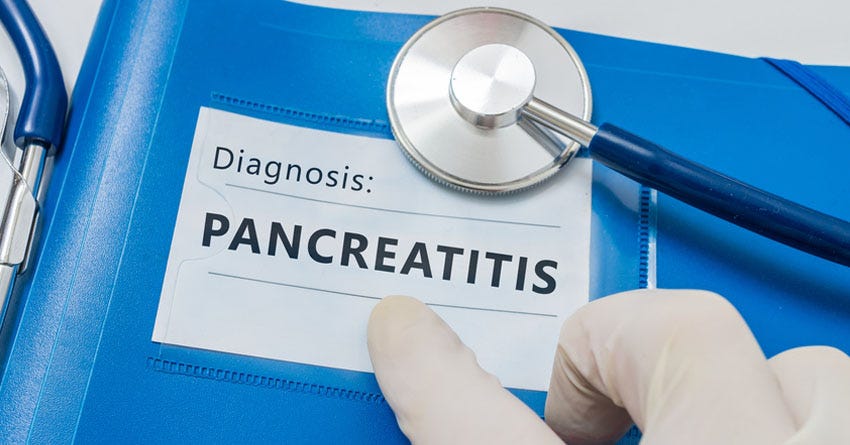Have you heard of pancreatitis? It’s a common, discomfort-producing, potentially fatal digestive tract ailment affecting many of our canine and feline companions.
The good news is that it’s preventable with appropriate preventive measures.
What is pancreatitis?
Pancreatitis is inflammation of the pancreas. Essentially, anytime the suffix ‘-itis’ is attached to a bodily structure it means “inflammation of the (insert favorite organ system here).” The pancreas is an important abdominal organ responsible for secreting digestive enzymes like amylase, lipase, and protease. Amylase aids digestion of carbohydrates, lipase facilitates fat breakdown, and protease promotes protein absorption. These enzymes are contained within granules that protect pancreatic and other tissues from enzymatic damage. The small intestine receives pancreatic enzymes through a series of ducts so food digests as it passes from the stomach into the duodenum, jejunum, and ileum (the three parts of the small intestine). The pancreas also has a crucial role in regulating blood sugar levels by secreting insulin into the bloodstream. Body tissues depend on insulin, as lack of or insufficient production of this vital hormone causes sugar to stay in the blood instead of entering muscles and other organ systems.
What causes pancreatitis?
Pancreatitis occurs when the pancreas becomes inflamed as a result of one or multiple inciting factors, including:
- Toxic exposure - Many household or environmental toxins cause digestive tract upset that leads to the pancreas becoming inflamed. Because of the close proximity to the intestines, inflammation of the digestive tract can lead to the granules releasing enzymes that damage pancreatic tissues.
- Dietary indiscretion - Consumption of trash, soil, feces, plants, rancid food and other substances in the home or outdoor environment is another cause of digestive tract inflammation and pancreatitis.
- Infection - Bacteria, viruses, parasites, and fungal organisms have potential to move from digestive tract into the pancreas or can be absorbed into the bloodstream and then enter the pancreas to cause damage.
- Trauma - Blunt trauma from being hit by a car, getting into a fight with another animal, taking a fall, and other causes can injure the pancreas and cause pancreatitis.
- Metabolic disease - Ailments affecting other glands, including the kidneys, liver and adrenal glands, can alter normal hormonal balances that directly or indirectly harm the pancreas.
- Cancer - Pancreatic cancer or that which metastasizes (spreads) from other parts of the body can damage the normal cells of the pancreas.
- High fat or high protein diets and treats - Commercially available pet foods, home-prepared pet foods and human foods can contain volumes of protein and/or fat that cause digestive tract inflammation and thereby affect the neighboring pancreas. There’s not a direct cause-and-effect relationship between dietary protein, fat and pancreatitis, but since both can cause intestinal inflammation at least some correlation exists.
What are the clinical signs of pancreatitis?
Some clinical signs of pancreatitis are obvious while others are subtle. You may not even know your canine or feline companion’s pancreas is inflamed until he’s acting sick. Unfortunately, there’s much crossover between the clinical signs of pancreatitis and other ailments, so we veterinarians must always keep pancreatic inflammation in mind when evaluating patients having digestive upset. Pancreatitis clinical signs include:
- Hyporexia or anorexia - Hyporexia is decreased appetite and anorexia means compete lack of appetite.
- Abdominal discomfort - The inflammation created by pancreatic cells being damaged from their own enzymes can cause abdominal discomfort manifesting as pain to the touch, rounding of the back/hunching up of the abdomen, lethargy, labored breathing, and other signs.
- Emesis (vomiting) - Due to intestinal inflammation commonly seen with pancreatitis the intestines don’t contract as well to move food and fluid in the correct direction, so there’s a greater likelihood that stomach and intestinal contents back up and vomiting occurs.
- Stools changes - Soft stools or diarrhea, including liquid consistency, explosive nature, increased urgency, straining, flatulence (“farting”), the presence of blood or mucus and others are associated with pancreatitis.
- Ptyalism (increased salivation or drooling) - The sensation of nausea caused by pancreatitis can lead to ptyalism.
- Lethargy and exercise intolerance - With abdominal discomfort there’s typically a commensurate reduction in overall energy and willingness to move. Thus, a pet can appear more tired (lethargic) and be less-willing to participate in activities (walking, playing, etc.).
- Behavior changes - Besides acting lethargic and having exercise intolerance, pancreatitis can cause pets to have difficulty resting/sleeping, pacing, etc.
How is pancreatitis prevented?
Pancreatitis can be a challenging and expensive disease to treat requiring extensive diagnostics (blood testing, x-rays, ultrasound, etc.) and days of intravenous fluids, medications, and other treatments at a veterinary hospital. Therefore, it’s best that pet owners avoid pancreatitis by taking the following measures:
- Prevent dietary indiscretion - If your pet doesn’t eat household or environmental materials that he otherwise should not, then there’s a lower likelihood he’ll suffer from digestive tract and pancreatic inflammation and damage.
- Keep your pet slim on a lifelong basis - Fat cells produce hormones capable of promoting inflammation. Thus, overweight and obese dogs and cats are more prone to ailments associated with inflammation like pancreatitis. Additionally, as body weight increases, the pancreas’ ability to produce enough insulin is lessened and diabetes can occur.
- Promote regular digestive tract function - If your pet’s stomach and intestines are kept functioning properly through the appropriate ratios of fats, proteins, carbohydrates, fiber, moisture, etc., it’s less likely that pancreatitis will occur. Reduced intestinal inflammation helps maintain normal levels of gut bacteria that competitively inhibit pathogenic (disease-causing) bacteria, viruses, parasites, and other infectious organisms from taking up residence and causing damage. Generally, my canine and feline patients eating human-grade, moist, whole-food diets and treats like those from The Honest Kitchen have reduced digestive tract problems and pancreatitis. Probiotics (beneficial bacteria), omega fatty acids, digestive enzymes, vitamins and minerals, and other veterinary-prescribed supplements can help maintain normal gut function. Honest Kitchen's Instant Goat's Milk contains 5 billion active probiotics.
- Schedule regularly veterinary exams - I recommend dogs and cats have a physical examination by a veterinarian at least every 12 months so bodily abnormalities that are not obvious to the owner can be properly diagnosed and treated. Pets having health problems or regularly taking medications should be examined more frequently.
Has your pet ever suffered from pancreatitis? Please feel free to share your story in the comments section. Interested in seeing the impact of diet on pets with pancreatitis? Read through our True Stories here.


